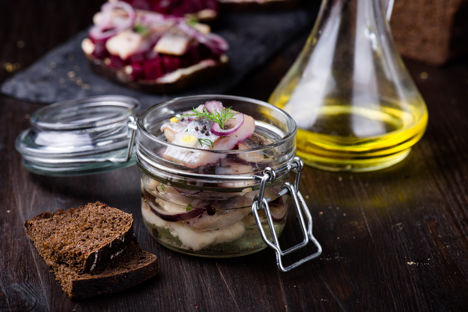
A guide to pickling fish
Chloë King busts the myths surrounding pickling fish, proving that it’s an easy, safe method that turns fresh produce into flavourful delicacies enjoyed all over the world.
A guide to pickling fish
Chloë King busts the myths surrounding pickling fish, proving that it’s an easy, safe method that turns fresh produce into flavourful delicacies enjoyed all over the world.
All seafood can be pickled but the process is most suited to oily fish like mackerel and herring. These fish undergo a delightful transformation in texture when cured and steeped in acidic liquor: the sharpness of vinegar or citrus creating livening dishes that feel like they’re doing you good – and they probably are.
This broad genre comprises all sorts of dishes, from Peruvian ceviche, (raw fish steeped in fresh lime) to Japanese shime saba (mackerel marinated in salt and rice vinegar) and boquerones en vinagre – delectable tapas of bite-sized anchovies in oil, vinegar and herbs.
The term escabeche translates from Spanish as pickle or marinade, and the process of fish pickling has more in common with marinating than it does with preserving veg in jars. Both ceviche and escabeche are derived from the Arabic al-sikbaj, referring to dishes with vinegar added towards the end of preparation. In his essential book On Food and Cooking, Harold McGee talks of how, in ancient times, escabeche was a method of making fried fish last longer.
It is, of course, also good to store pickled fish and seafood long-term in jars and cans – as we do the cockles and mussels traditionally consumed in East London pubs and with surströmming, the famously foul-smelling Swedish delicacy. To create surströmming, herring undergoes a long wild fermentation process that continues even after canning, to a point where it is considered at its edible peak when the container looks fit to explode.
Most suitable for the home cook, however, is short refrigerator pickling that can be achieved in just a few days. It’s easy to create the Scandinavian favourite pickled herring in all its delightful variations with little more than some super fresh fish, good quality vinegar, sea salt, a plastic container, a refrigerator and a long weekend.
Catch of the day
An important thing to consider before you begin your fish pickling adventure is that some fish requires pre-freezing in order to destroy parasites. The EU requires food businesses to pre-freeze fish that are intended to be sold raw or lightly cooked, which means keeping at -20°C for no less than twenty-four hours before serving or processing. There are some exceptions, such as FSA-authorised catches and farmed Atlantic salmon, so it’s worth asking your fishmonger what applies.
General rules include using the best ingredients possible – primarily the freshest, firmest fish and keeping good hygiene by sterilising chopping boards and containers. It’s also important to keep a cool environment and to be exact in how many preservatives to add: that is the balance of salt, sugar and acid. As with all pickles, these staple components are embellished by the introduction of herbs and spices such as bay, fennel, juniper, mustard and dill, through either hot or cold infusion of your pickling liquor.
The most common methods of fish pickling can be categorised into cooked (or soused), raw and pre-cured (where the fish is salted or brined). Pickling raw fish generally takes a minimum of five days. Some fish that has been pre-cured requires de-salting in water for twenty-four hours and then pickling for a minimum of twenty-four hours. Cooked fish requires even milder marination because it contains fewer bacteria, but this results in ‘less development of flavour and texture,’ observes Harold McGee.
Nordic-style pickles are typically pre-cured and then steeped in sweetened vinegar. Harold McGee states that these Northern European pickles are commonly made over one week. By comparison, Japanese shime saba is salted for twenty-four hours then pickled for twenty-four hours.
Jane Grigson recommends a quick salting method using ten percent brine, submerging fillets for a minimum of three hours before pickling right away. Alternatively, Hugh Fearnley-Whittingstall’s pickled herrings, adapted from Rick Stein, are salted for only half an hour in a much stronger brine (two kilos of salt to six litres of water), then pickled in spiced wine and wine vinegar for one to three days. Fully dry-salted fish can be left for three months or more.
It’s through playing about with these curing ratios that chefs can achieve appealing differences in flavour and texture. The transformative chemistry of curing and pickling is no more fascinating than when used to influence the delicate flesh of fresh fish, so it’s a fascinating method to experiment with.


